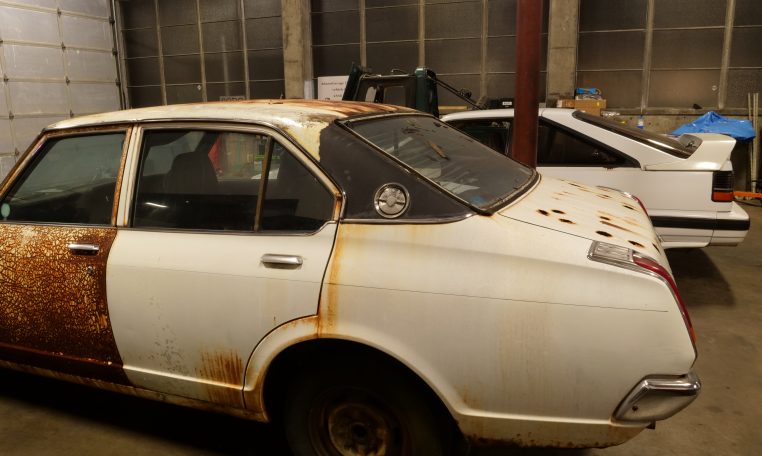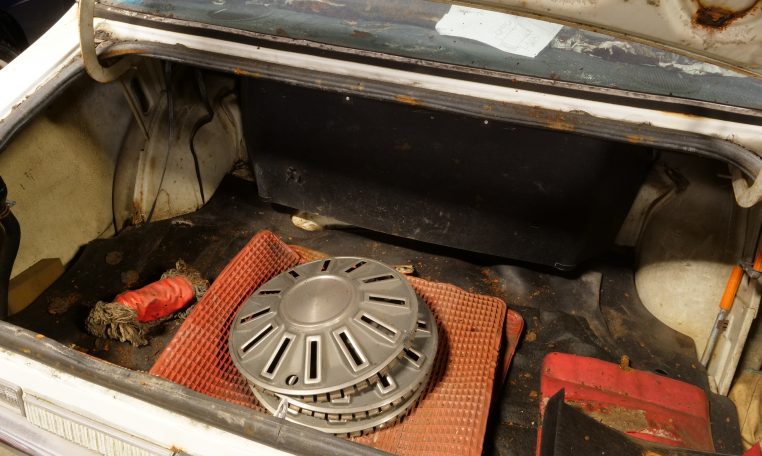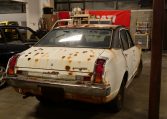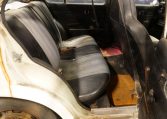1972 Toyota Carina TA21
Classic Toyota Carina sedan – 2TC / 5-speed with factory air conditioning.
Sitting many years, exterior rust but interior is pretty solid. The day it arrived, we installed new points, confirmed spark, cleaned the plugs and it fires right off on starting fluid. Clean the fuel and go for the ‘patina’ look. Or fantastic donor if you already own a Carina.
From Wikipedia – The first-generation Carina was manufactured from December 1970, and sold at Toyota Store dealership channels in Japan, sharing its platform with the Toyota Corolla Store exclusive Toyota Celica sports coupe, while the already established Toyota Corona was sold at Toyopet Store locations. Its European release took place in October 1971.[1] Toyota was able to save development and tooling costs by building a family sedan and a sports car on the same platform and in the same factory. The Carina filled the size gap between the smaller Corolla and the larger Corona.
Show room appeal was enhanced by the inclusion in the price of reclining seats with built-in head restraints, radio, clock, reversing lights and servo-assistance on the brakes: these were features which, where available on competitor models, tended to be offered only as options at extra cost.[2]
The chassis code was A10, with A15, 17 and 18 being reserved for hardtop coupés. Excepting the anomalous RA16 hardtop, A16 and 19 were used on vans (utility wagons). Beginning in 1975, A30-series numbers were used for some hardtop coupés. The wagons/vans of the first generation were not regularly exported. Carina vans entered production in December 1975.[3]
The A10 Carina was also exported to the US, but its introduction coincided with the introduction under President Nixon of a 10% import duty[4][5] and sales volumes were disappointing. Cars destined for export were increasingly switched towards other markets in Europe[5] and elsewhere, and US exports stopped after only two years: instead the company progressed with plans to build car plants in the USA.
The original model usually featured a choice of a 1407 cc OHV (T) or 1588 cc OHV (2T) engine, choice of a four-speed manual gearbox, two-speed automatic gearbox or three-speed automatic gearbox and front-wheel disc brakes (drum brakes on the lowest model).[1] It was revised in 1972 with a restyled body, new rear light cluster, filler cap repositioned in the rear quarter panel, restyled front grille and fascia. The specification was once again revised in 1974 including sealed cooling system, improved brakes, restyled wheels with flared wheel arches, and restyled interior fittings.
In late October 1975 (on sale 1 November), the Carina received a new front and rear-end styling, dual-line braking system with servo, and a repositioned handbrake and gear lever in a modified dashboard. The wheelbase and tread were increased slightly, as for the sister Celica series.[6] Some chassis codes were accordingly changed, and the Japanese market cars received a plethora of altered engines, ranging from 1.4 to 2.0 liters.[7]
Vehicles installed with engines with displacement at 1.5 litres or larger obligated Japanese owners to pay more annual road tax, and were considered top trim level packaged cars. Toyota introduced the “TTC-V” (Toyota Total Clean-Vortex) on the 19R engine only, using an exhaust gas recirculation implementation to comply with recently enacted emission regulations passed by the Japanese Government. The 1.4 was dropped from sedans and coupés, and a mid-range 1.8 was added at the time of the late 1975 facelift.[8]
In December 1975 a Van version was developed, featuring the same facelifted front end. The new rear end uses the cargo door of the 30-series Corolla wagon. The Carina Van also received a very unusual opera-style side window in the cargo area, and was available with the 1400 or 1600 T-J/2T-J engines with 80 or 93 PS (59 or 68 kW).[9] The Carina Van was generally not exported. The Van’s TA16V/TA19V chassis codes continued to be used for the next-generation Van, until it was facelifted again in August 1979. To bring these models in line with the second-generation Carina, they then received a new TA49 chassis code.[10]
Though this one's sold, contact us if you're interested. We may be able to locate another one for you.







































